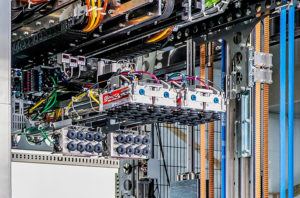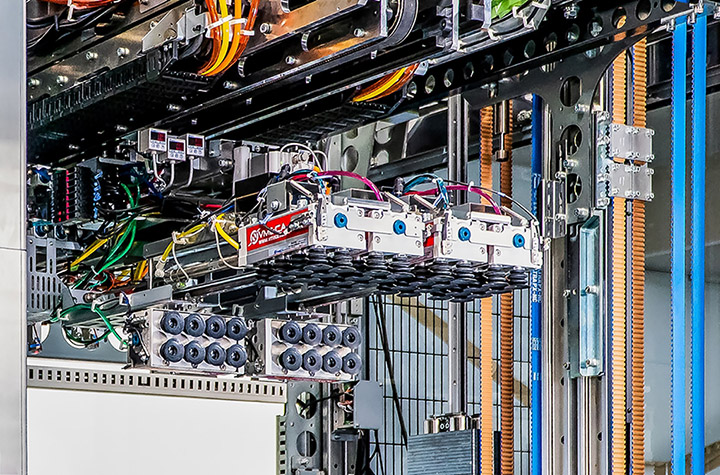
The global logistics sector is growing exponentially as international trade flourishes and global supply chains are expected to be more efficient, smarter and more sustainable to support capital and information flows and exchanges. To address this need, companies are seeking next-generation logistics and efficient delivery management solutions. This is where Toshiba can help.
Toshiba has solutions which can be adopted at various warehouse points to carry out tasks such as unloading, picking and loading. Using advanced sensors for image recognition, virtual models to simulate complicated conditions and robotic functions to automate transportation of goods, Toshiba’s suite of service offerings eliminates labor intensive operations to contribute to a faster and more efficient logistics environment.
One of Toshiba’s technologies is the De-Palletizer Robot, which uses robotics technologies to innovate the work at logistics sites. https://youtu.be/W5wyqakI27U (This video was released on January 23, 2019.)
Image recognition technology and a robot that needs no prior instruction
“Logistics sites in Japan tend to be located near highway interchanges – while this facilitates easier transportation of cargo and goods, there are manpower challenges since these sites are less accessible by public transport. Another reason for this shortage is tasks are physically demanding since the goods that arrive at the sites from factories and warehouses can be heavy, and it is hard work to sort and organize them by destination. Recognizing this challenge, we started developing a de-palletizing robot three years ago.” remarks Hideto Yui, Head of Business Unit Robotics, Logistics System Solutions, Security & Automation Systems Division, Toshiba Infrastructure Systems & Solutions Corporation (title at the time of the interview).
“Toshiba De-Palletizer Robot can handle loads of up to 30kg with certainty. It’s also small, at 2.2m wide, 3.4m deep, and 2.7m high, which means it is compact and can easily be attached to existing equipment. One distinctive feature is that it’s teach-less(Using artificial intelligence and machine learning, the robots are able to easily respond to parcels of varying sizes.), in that it automatically recognizes the condition of the boxes and determines what it should do with it. The robot is able to de-palletize at a rate of over 8 boxes a minute, theoretically 24 hours a day. We are harnessing our knowledge and strengths in the image recognition technology to be applied in logistics sites,” says Yui.
Boxes on pallets are not always arranged the same manner, though it would be convenient if they were. Previously, workers had to register the pattern for each layer of boxes before the equipment could detect what it was handling. This new Toshiba robot, however, uses a combination of Toshiba’s camera and sensor technologies to measure various factors, including evaluating the distance to the boxes using the reflection speed of the radar, etc., to recognize the conditions of the boxes automatically and handle them on its own.
“It detects and measures accurately of the space between boxes, identifies differences in where the top of the boxes meet, etc., and automatically recognizes how they’re piled, even if they’re not in any set pattern or if the boxes in each layer have different designs,” says Yui.
Helps improve efficiency in logistics sites
Another distinguishing feature of this robot is the way it moves the boxes onto a conveyer belt. Its two-sided gripping function (orthogonal mechanism) (Gripper type is two-sided gripper -top and side) consists of grips, equipped with suction cups which stick onto the top of the box and the side closer to the robot, as it moves the object.
By distributing the weight to two sides — the top and the side — it can even move boxes made of delicate materials, like those with perforations on the top, securely and without causing damage.
“In our initial prototypes, the robot only gripped the top of the boxes. But boxes are made by various manufacturers and some of them are less sturdy than others, so the perforations on top would rip, or it wouldn’t be stable, and the robot would lose its grip on the box. We looked into it, and found that the exterior of the boxes are covered in paste, and are stuck firmly together. This is called anti-slip processing, and manufacturers do this so the boxes don’t come apart and fall off when they’re moving pallets via forklift. In summer when it’s humid, the manufacturers make the paste weaker, and in the dry months they make it really strong. The boxes that have been processed with the stronger paste are hard to lift even for people—just lifting them up can cause the boxes to open. As you can imagine, it was even harder to do with a machine. So we decided to give the robot two grips to move the boxes into the lifting conveyor, the top and the side closer to it, and made it so that it could push and pull the boxes slightly apart,” says Kenji Furuta, Group Manager of Robotics, Logistics System Solutions Sales & Marketing Dept., in the same company (title at the time of the interview).
“A box with six 2L bottled drinks can weigh up to 12kg. Depending on the way the boxes are placed, Toshiba’s robot can handle a maximum of 500 to 600 boxes an hour without any downtime, reducing human involvement and increasing efficiency. The robot also frees up human resources for other tasks, and helps improve efficiency in these sites as a whole. What makes this robot so great as well is that it can remain teach-less in the future, even when the products being handled become more diverse or complex, because it uses image recognition technologies. Automation, using AI and machine learning, is leading the way in how we operate in a logistics environment,” says Furuta.
The De-Palletizer Robot has been in operation since March 2018. The adoption and responses from the sites have been very positive; with reports that validates this automation process has helped them improve productivity. “Many of them have said they want the robot to be able to handle more types of de-palletizing work. In the future we want to apply to the technology to loading as well,” says Furuta.
In the future, Toshiba plans to incorporate deep learning and other new technologies to improve the performance of the robot such as enhancing its ability to recognize more types of boxes and increasing the accuracy of its movements—and to take it to even greater heights, whether that be a loading function or distribution to overseas markets.
“At the Security & Automation Systems Division, most of our technologies are based on three elements—the image recognition technologies we used to develop automatic ticket gates, cash sorting machines, mail sorting machines, etc., the mechanisms used to handle objects, and the planning/control of these mechanisms. These three elements are what we’re most familiar with as well. As the logistics industry grows in the future, we’d like to contribute in ways we can, improving the efficiency, and much more,” says Yui.
The growing popularity of e-commerce has upped the demand in the logistics industry. A happy trend, but one that lays bare the need to find solutions for the labor shortage and for improving productivity at these logistics sites. Toshiba’s De-Palletizer Robots may be just the thing to lend a helping hand.




